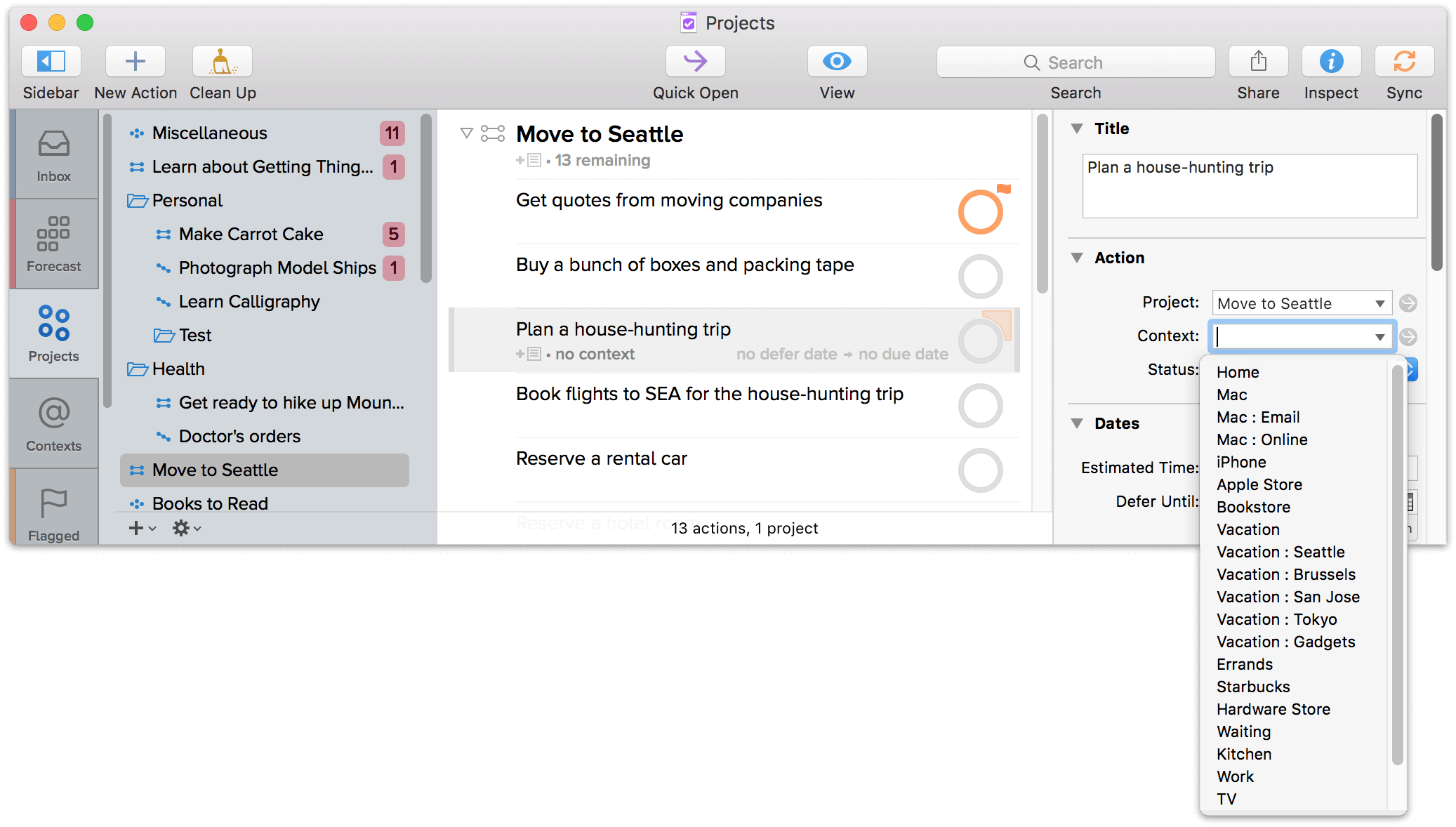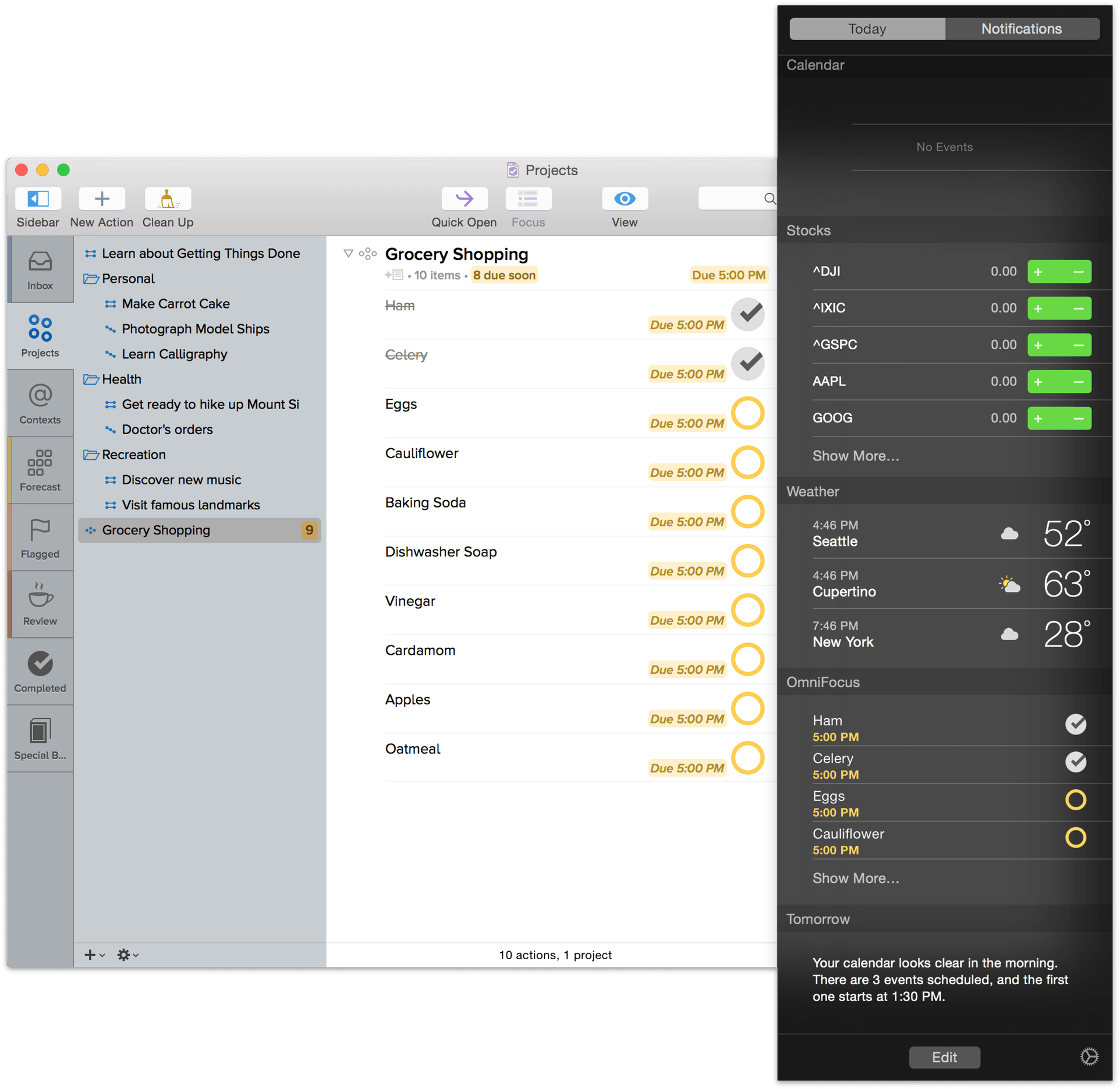They are running Objective-C and Swift on Mac servers that then output to the web. This isn't a simple web application. This is a Mac application driving to the internet. The OmniGroup explains in further detail at Inside OmniFocus. OmniFocus Standard and Pro are in-app purchases, with discounts for people who bought earlier versions of OmniFocus for Mac through the Mac App Store. Download the app for details. Use OmniFocus to accomplish more every day. Create projects and tasks, organize them with tags, focus on what you can do right now — and get stuff done. OmniFocus for the Web is a browser-based companion app that works in tandem with OmniFocus for Mac and iOS to provide access to the core features of OmniFocus from any modern web browser. The app is provided as an optional subscription-based add-on to your existing OmniFocus purchase, or as part of an OmniFocus subscription package. OmniFocus for Mac (the subject of this manual) is available both on the Mac App Store and directly from The Omni Group. OmniFocus for iOS is available on the App Store, and works on all of your iOS devices as well as your Apple Watch (through the OmniFocus for Apple Watch extension). OmniFocus was launched in 2008 and designed around the Getting Things Done (or GTD) methodology from David Allen's book by the same name. It's a powerful to-do list app for Mac and iOS that manages everything you need to do, keeping you productive by showing you exactly which task you should do next.
OmniFocus 3 adds power and flexibility — while also making it easier to get started and easier to work the way you want to work.
We've replaced contexts with tags, made scheduling and notifications more flexible, updated the design, added automation and collaboration features — and even created a web app, since not everybody always has their Mac, iPhone, or iPad available.
In future posts we'll go into more details with each of these — but, for now, we'll quickly highlight a few upcoming features. Note that not all of the below will appear in the initial 3.0 release (though tags will).
Omnifocus For Mac Manual Software
Tags
We've replaced contexts with tags. Tasks and projects can have multiple tags instead of just a single context.
Consider the case where you want to talk to Alice at work when your energy level is high. (Since Alice imparts a lot of useful information quickly!) Instead of applying a #work context to that action, you would tag it with #work, #Alice, and #high-energy.
You'll be able to view every task and project with a specific tag, re-order items within that list, and sync that order across devices. You'll also be able to create custom perspectives that show this tag or that tag, or this tag and another tag but not this other tag.
Like contexts, tags can be nested: you might have a #people tag with #Alice and #Joe as child tags. Tags do everything contexts do — and more. And they're a thing people are used to. Even the Finder has tags these days!
Automation
While the Mac version has always had strong AppleScript support, we know our users need something powerful that works on Macs and on iOS.

To that end we're adding JavaScript support — the same Omni Automation system that already appears in OmniGraffle and OmniOutliner — that will allow you to write scripts that work on both Macs and iOS and across Omni apps.
You'll be able to create reports, run powerful filters, create projects and tasks based on templates, and plenty more. You'll be able to do things we haven't even thought of — which is the point of automation.
Collaboration
With OmniFocus's new collaboration features, I could send you a task with all its data, and you could accept, which links this task across our databases.
While the task is linked, both of us will see updates to that task, including status updates. One of us may add sub-tasks, and one of us might not. One of us might move it to a different project. The task remains linked.
This lets you keep using OmniFocus for your personal task management, while still allowing for flexibility and for the sharing that you need.
OmniFocus for the Web
We've heard from plenty of people that they're in front of a Windows machine at work — or that they, for whatever reason, sometimes have access to a browser but not to OmniFocus.
OmniFocus for the web will allow people to view their projects and tasks, edit them, complete them, and make new ones. It will be simplified compared to the Mac or iOS app — it won't include custom perspectives and similar features. But we believe it will handle most of what people need when they're away from their Mac or iOS device.

To that end we're adding JavaScript support — the same Omni Automation system that already appears in OmniGraffle and OmniOutliner — that will allow you to write scripts that work on both Macs and iOS and across Omni apps.
You'll be able to create reports, run powerful filters, create projects and tasks based on templates, and plenty more. You'll be able to do things we haven't even thought of — which is the point of automation.
Collaboration
With OmniFocus's new collaboration features, I could send you a task with all its data, and you could accept, which links this task across our databases.
While the task is linked, both of us will see updates to that task, including status updates. One of us may add sub-tasks, and one of us might not. One of us might move it to a different project. The task remains linked.
This lets you keep using OmniFocus for your personal task management, while still allowing for flexibility and for the sharing that you need.
OmniFocus for the Web
We've heard from plenty of people that they're in front of a Windows machine at work — or that they, for whatever reason, sometimes have access to a browser but not to OmniFocus.
OmniFocus for the web will allow people to view their projects and tasks, edit them, complete them, and make new ones. It will be simplified compared to the Mac or iOS app — it won't include custom perspectives and similar features. But we believe it will handle most of what people need when they're away from their Mac or iOS device.
More…
The above is light on detail and skips a number of important features, but we promise to write more posts to fill you in on everything. And there will be delicious screenshots. :)
But, for now, you can read the second half of the Omni Roadmap 2018 blog post, where it concentrates on OmniFocus 3, and you can listen to Ken Case talk about OmniFocus 3 on The Omni Show.
You're also welcome to ask questions via Slack, Twitter, Micro.blog, the forums, or by contacting support.
I'll be honest, I enjoy reading productivity books about as much as I enjoy reading about riding a bicycle. I just don't find the advice very useful in my own life. 'Productivity' books can feel a lot like a pyramid scheme where each subsequent author retells ideas from other books. I've rarely found a 'self help' book that provided more value than David Allen's Getting Things Done. I do, however, enjoy a good technical manual which is what brought me to Kourosh Dini's 'Creating Flow with OmniFocus' many years ago. The book was just updated for OmniFocus 3 and is well worth the price of admission for anyone using OmniFocus for complex task management.
'I suspect that many otherwise well-founded productivity systems collapse somewhere when lists grow unwieldy. It is for these reasons that unless we are in a planning mode, we systematically hide tasks that do not pertain to what we want in front of us now.'
Creating Flow walks a fine line between a philosophy and technical guide. It's one third instruction manual, one third cautionary exposition, and one third philosophical analysis of task management. I'm not one to adopt philosophies that I don't create from first principles but I find Kourosh's suggestions compelling. The unique perspective is likely derived from Kourosh's own profession of psychiatry but with a practical approachability useful in many other fields.
My needs and approach to task management only overlap with Kourosh's at a high level. In some aspects we are simpatico, such as our aversion toward energy-level prioritization. In other aspects we couldn't be further apart, such as his strategy of moving tasks between projects and folders as work proceeds. The book acknowledges these likely conflicts and attempts to provide alternatives even if they are not part of his personal doctrine. Even with this balancing act, the tone never comes off as wishy-washy or contrived. Kourosh clearly lives in OmniFocus and offers his experience as a sort of trail guide for the lost. He carefully avoids a prescriptive town while still outlining his own use cases.
Omnifocus For Mac Manual Download
There are some new useful ideas in the book I've rarely seen elsewhere. The end of the book is entirely focused on the use of OmniFocus perspectives and templates in much more depth than even the Omnigroup teaches. While the book has significant documentation on the application settings, much of Kourosh's attention is on how switching between perspectives and Focus mode can sift through large task lists and maintain order. Kourosh provides some guidance on what he calls 'Depth' and 'Launch' views and how these can balance each other. None of these are required (or desirable) for my work but his explanation is useful in considering where friction arises in large, busy task lists.
Creating Flow with OmniFocus 3 is not really an application manual. It feels more like a continuation of the concepts David Allen espoused in Getting Things Done over a decade ago. It just so happens that Kourosh Dini is telling his story with OmniFocus as the backdrop. Many pages include footnote references to Getting Things Done. But it is all presented in the framework of OmniFocus' strengths and weaknesses.
My complaints are minor for this new version. First, there is much more focus on OmniFocus for Mac than for iOS. Where there is attention for iOS, it's mostly for the iPhone version. In my life, OmniFocus for the Mac is often the last place I want to work. Circumstances force me into working from iOS and advice for how to manage these complex workflows on a mobile device would provide me much more bang for the buck.
My second complaint may be more of a feature for many. Creating Flow with OmniFocus 3 relies on 'creative' work examples heavily. While I'd prefer to do creative work, my day job is much more concerned with putting out spontaneous fires and managing groups of people. Few books have helped me with these problems. On the other hand, anyone that has a creative job involving the arts or a regular consistent schedule will have ideal use cases available in this book.
Omnifocus For Mac Manual Downloads
This update is available as a PDF download, which makes its a perfect reference for OmniFocus. I added it to an 'Improve OmniFocus' project as reference material and put the task on hold. The PDF is only a search away from anywhere I have OmniFocus.
